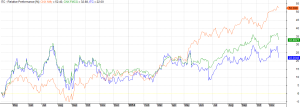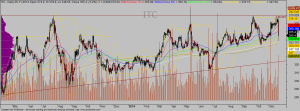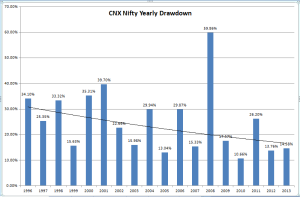Evenings on Twitter are generally spent talking about either our markets or the US markets. Today though, much of the discussion so as to say was with regard to making fun of RJ’s target of 1,50,000 for Nifty, mind you Nifty and not Sensex by 2030.
Extrapolation is easy given the tools we have at our disposal. But should the ridiculous target broach us away from the fact that on the long term, markets have gone only one way – Up. And before you point me Nikkei, I would request you to start your Nikkei calculations not from 1980, but 20 – 30 years earlier. From that point, even after the relentless weakness, Nikkei is still very much in positive territory.
Big targets always make nice talking points, but unfortunately, investing for that kind of growth requires a certain rigor and discipline that is not seen in most of us. The best way for 95% of folks is to have a systematic investment plan to invest X% of Salary into a few Mutual Funds (Large Cap / Small Cap) regularly come rain or shine.
Of course, doing that will mean that you may not be able to see your accounts double in a year but what it will ensure is that at the end of 15 / 20 / 25 years, you have a sizable amount as savings which has grown at a rate which would not be possible in most other asset classes (including Real Estate, though there will always be exceptions).
At the current juncture, market’s aren’t cheap by any meaningful measure, but if you are looking at the very long term, any entry is as good as another. Even opportunity costs can make a huge difference in end results.
RJ is no Buffett and as his recent investment into Spicejet shows, even when he invests into what he believes is a solid bet, his allocation is so small so as to not hurt him if it fails. But, the bottom line is that, unless one takes some kind of risk, one can never hope to get a reward.
Markets are cyclic in nature and at some point in future, we could see even a fall of 50% from the top, but if you wait for it and the 50% drop comes after market itself has moved 100% from here, you are still worse of compared to what you would be if you had invested. Worse of all, its easy to say that one will invest when blood is on the street. When blood really flows, rarely do even those with a plan can stick to their plan of action. Fresh investments generally never happen at such times even if RJ says, Sell your House, Buy Nifty 🙂
The biggest advantage (as of right now) into Equity investing is that Long Term returns are Tax Free. This is something that no other asset classes offer and if you were to believe that India has a long way to go as we try and catch up with the developed world, no date is too late.


